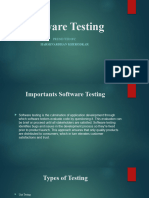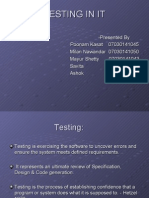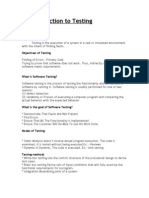0 ratings0% found this document useful (0 votes)
4 viewssoftware testing life cycle
The document outlines various software testing methodologies including manual, automation, API, performance, and security testing, emphasizing their importance in ensuring software quality and user experience. It details the systematic Software Testing Life Cycle (STLC) and highlights different testing types such as unit, integration, and functional testing, along with their respective benefits and tools. Additionally, it addresses common challenges in testing and provides best practices for effective testing strategies.
Uploaded by
madhankumar.gCopyright
© © All Rights Reserved
Available Formats
Download as PDF, TXT or read online on Scribd
0 ratings0% found this document useful (0 votes)
4 viewssoftware testing life cycle
The document outlines various software testing methodologies including manual, automation, API, performance, and security testing, emphasizing their importance in ensuring software quality and user experience. It details the systematic Software Testing Life Cycle (STLC) and highlights different testing types such as unit, integration, and functional testing, along with their respective benefits and tools. Additionally, it addresses common challenges in testing and provides best practices for effective testing strategies.
Uploaded by
madhankumar.gCopyright
© © All Rights Reserved
Available Formats
Download as PDF, TXT or read online on Scribd
You are on page 1/ 16
Understanding Manual, Automation,
API, Performance, and Security Testing
Definition: Process of evaluating and verifying that a software application
meets requirements
Importance:
◦ Ensures software quality
◦ Identifies defects early
◦ Improves security and reliability
◦ Enhances user experience
STLC is a systematic process of testing
software to ensure quality and efficiency
Unit Testing
Integration Testing
Manual Testing
Automation Testing
API Testing
Performance Testing
Security Testing
Manual testing includes testing a software manually i.e. without
using any automated tool or any script.
In this type, the tester takes over the role of an end user and tests
the software to identify any unexpected behaviour or bug.
Benefits:
Identifies user experience issues
Effective for small projects
Best for exploratory and usability testing
Effective in finding UI/UX issues
No knowledge of internal program or code is required
Testing happens based on requirements and functionality
White box Testing
Knowledge of internal program design or code is required
Focuses on code logic, paths, and conditions
Typically performed by developers or testers with programming knowledge
Tests individual components or functions of the software
Done at the development stage by developers/Testers
Comes under White box testing (the tester has full knowledge of the internal
workings of the system, including the code, architecture, and logic )
Tests how different units/modules interact with each other
Comes after unit testing and ensures modules work together
correctly
Example: Checking if a login module interacts correctly with a
database
Approaches: Top-down, Bottom-up, Big Bang, and Hybrid
Integration Testing
Tools: Postman (for API integration)
Definition: Automation testing uses scripts and tools to execute test
cases automatically, reducing human effort and improving efficiency.
Why Automation Testing?
◦ Increases test execution speed and accuracy
◦ Allows for frequent and repetitive test execution
◦ Reduces human errors
◦ Supports continuous integration and continuous delivery (CI/CD)
Common Tools: Selenium, Cypress, TestNG, JUnit, Appium (for mobile
testing)
Functional testing is a type of software testing that focuses on verifying
whether the software application functions as intended and meets the
specified functional requirements.
It involves evaluating the software's features, functions, and user
interactions to ensure that it performs correctly and delivers the expected
results.
Testing an application from its non functional attributes
Non functional testing involves testing a software from the
requirements which are non functional in nature.
Types of non functional testing
Performance testing
Load testing
Stress testing
Usability testing
Definition: API testing verifies that an application’s APIs function as expected
by checking request-response behavior, data integrity, and security.
Key Aspects of API Testing:
◦ Validation of API requests and responses
◦ Authentication and Authorization Testing (OAuth, JWT, API keys)
◦ Error handling and status code verification
Definition: Performance testing evaluates an application’s responsiveness,
stability, and scalability under different loads.
Definition: Security testing ensures that an application is protected from
potential security threats and vulnerabilities.
Key Areas of Security Testing:
◦ Authentication Testing: Verifying user identity mechanisms
◦ Authorization Testing: Ensuring users have appropriate access levels
◦ Vulnerability Scanning: Identifying weaknesses in the application
◦ Penetration Testing: Simulating attacks to find security flaw
Incomplete or Ambiguous Requirements
Time Constraints
Resource Limitations
Testing Complex Systems
Dynamic and Changing Environments
Test Data Management
Dependency on External Systems
Reusability of Test Cases
Lack of Test Environment Stability
Defect Management
Early Testing: Start testing as early as possible in the development lifecycle to
catch defects early.
Clear Test Planning: Define objectives, scope, and test strategy before execution.
Use of Test Automation: Automate repetitive and critical test cases to save time.
Comprehensive Test Coverage: Ensure testing covers all functional, non-
functional, and edge cases.
Continuous Testing: Integrate testing into the CI/CD pipeline for faster delivery.
Effective Bug Reporting: Provide clear, detailed bug reports with steps to
reproduce and expected vs. actual results.
Security and Performance Testing: Always include security and load testing in
the testing strategy.
You might also like
- Quality Assurance For Beginners. Expand Your QA Vocabulary - by Nick Babich - MediumNo ratings yetQuality Assurance For Beginners. Expand Your QA Vocabulary - by Nick Babich - Medium13 pages
- Croma Campus - Software Quality Testing CourseV4.0No ratings yetCroma Campus - Software Quality Testing CourseV4.039 pages
- Quality Assurance in Software Project Management: Presented By: Muhammad Imran Malik Muhammad Ouns Qureshi Nasir AnsariNo ratings yetQuality Assurance in Software Project Management: Presented By: Muhammad Imran Malik Muhammad Ouns Qureshi Nasir Ansari14 pages
- Software Testing Algorithm Units: American Journal of Engineering Research (AJER)No ratings yetSoftware Testing Algorithm Units: American Journal of Engineering Research (AJER)5 pages
- The Importance of Software Testing in The Development LifecycleNo ratings yetThe Importance of Software Testing in The Development Lifecycle3 pages
- Software Engineering Unit 4 - @mrsandyy_No ratings yetSoftware Engineering Unit 4 - @mrsandyy_6 pages
- Eeee1231 Software Engineering - Software Verification and ValidationNo ratings yetEeee1231 Software Engineering - Software Verification and Validation10 pages
- Lecture 15 - Introduction To Software Testing-1721286822153No ratings yetLecture 15 - Introduction To Software Testing-172128682215346 pages
- Week2 - Day3 - CICD Testing, and Deployment ProcessNo ratings yetWeek2 - Day3 - CICD Testing, and Deployment Process14 pages
- Automation Testing note Intellepath2021No ratings yetAutomation Testing note Intellepath202118 pages
- Quality Assurance Testing from Beginner to Paid Professional, 1: Everything You Need to Know to Start a Career in Manual and Automated QA TestingFrom EverandQuality Assurance Testing from Beginner to Paid Professional, 1: Everything You Need to Know to Start a Career in Manual and Automated QA Testing5/5 (1)
- 2.business Area Analysis and Requirement Definition100% (1)2.business Area Analysis and Requirement Definition7 pages
- Ganesh Santhar Huawei 4.05 Years BangaloreNo ratings yetGanesh Santhar Huawei 4.05 Years Bangalore3 pages
- On-Premises Versus Secaas Security Models: AbstractNo ratings yetOn-Premises Versus Secaas Security Models: Abstract6 pages
- En 62061 and Recommendations For The Practical Use - Derek Jones100% (1)En 62061 and Recommendations For The Practical Use - Derek Jones17 pages
- Madan Krishna Siwakoti: Java Developer Professional SummaryNo ratings yetMadan Krishna Siwakoti: Java Developer Professional Summary3 pages
- CSE4017 - SOFTWARE-TESTING - LT - 1.0 - 1 - Software TestingNo ratings yetCSE4017 - SOFTWARE-TESTING - LT - 1.0 - 1 - Software Testing2 pages
- What Is Software?: Applications Are of Two TypesNo ratings yetWhat Is Software?: Applications Are of Two Types11 pages
- Systems: Early Design Space Exploration With Model-Based System Engineering and Set-Based DesignNo ratings yetSystems: Early Design Space Exploration With Model-Based System Engineering and Set-Based Design19 pages
- 2 Software Design Processes and Management: 1. The Figure Below Indicates The Errors in The DiagramNo ratings yet2 Software Design Processes and Management: 1. The Figure Below Indicates The Errors in The Diagram10 pages
- ALV Grid in The Nutshell Field Catalog - Col - Id - ALV Control Column IDNo ratings yetALV Grid in The Nutshell Field Catalog - Col - Id - ALV Control Column ID6 pages
- Vendor Risk Assessment Questionnaire - HyperComplyNo ratings yetVendor Risk Assessment Questionnaire - HyperComply13 pages
- Quality Assurance For Beginners. Expand Your QA Vocabulary - by Nick Babich - MediumQuality Assurance For Beginners. Expand Your QA Vocabulary - by Nick Babich - Medium
- Croma Campus - Software Quality Testing CourseV4.0Croma Campus - Software Quality Testing CourseV4.0
- Quality Assurance in Software Project Management: Presented By: Muhammad Imran Malik Muhammad Ouns Qureshi Nasir AnsariQuality Assurance in Software Project Management: Presented By: Muhammad Imran Malik Muhammad Ouns Qureshi Nasir Ansari
- Software Testing Algorithm Units: American Journal of Engineering Research (AJER)Software Testing Algorithm Units: American Journal of Engineering Research (AJER)
- The Importance of Software Testing in The Development LifecycleThe Importance of Software Testing in The Development Lifecycle
- Eeee1231 Software Engineering - Software Verification and ValidationEeee1231 Software Engineering - Software Verification and Validation
- Lecture 15 - Introduction To Software Testing-1721286822153Lecture 15 - Introduction To Software Testing-1721286822153
- Week2 - Day3 - CICD Testing, and Deployment ProcessWeek2 - Day3 - CICD Testing, and Deployment Process
- Quality Assurance Testing from Beginner to Paid Professional, 1: Everything You Need to Know to Start a Career in Manual and Automated QA TestingFrom EverandQuality Assurance Testing from Beginner to Paid Professional, 1: Everything You Need to Know to Start a Career in Manual and Automated QA Testing
- 2.business Area Analysis and Requirement Definition2.business Area Analysis and Requirement Definition
- On-Premises Versus Secaas Security Models: AbstractOn-Premises Versus Secaas Security Models: Abstract
- En 62061 and Recommendations For The Practical Use - Derek JonesEn 62061 and Recommendations For The Practical Use - Derek Jones
- Madan Krishna Siwakoti: Java Developer Professional SummaryMadan Krishna Siwakoti: Java Developer Professional Summary
- CSE4017 - SOFTWARE-TESTING - LT - 1.0 - 1 - Software TestingCSE4017 - SOFTWARE-TESTING - LT - 1.0 - 1 - Software Testing
- Systems: Early Design Space Exploration With Model-Based System Engineering and Set-Based DesignSystems: Early Design Space Exploration With Model-Based System Engineering and Set-Based Design
- 2 Software Design Processes and Management: 1. The Figure Below Indicates The Errors in The Diagram2 Software Design Processes and Management: 1. The Figure Below Indicates The Errors in The Diagram
- ALV Grid in The Nutshell Field Catalog - Col - Id - ALV Control Column IDALV Grid in The Nutshell Field Catalog - Col - Id - ALV Control Column ID
- Vendor Risk Assessment Questionnaire - HyperComplyVendor Risk Assessment Questionnaire - HyperComply

























































































